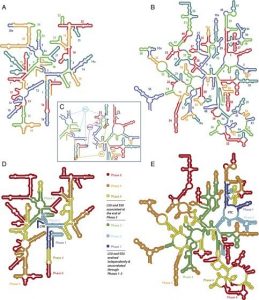This post is going to look at something I found from the results of 2 studies looking at the ribosome, the molecular machine that translates the genetic code into a string of amino acids that fold into the 20,000+ proteins that build and make us.
The first paper Evolution of the ribosome at atomic resolution peels the large subunit ribosome apart stem-loop by stem loop. They have a second paper with the small subunit which I took some figures from. A stem loop is a loop shaped structure where you have a base paired nucleotide “stem” and above that the rest of the structure forms a “loop”, often with more stem parts. These are how ribosomes tend to evolve. Sequence changes have more of a negative effect than insertion of something that adds new functions.

In the top portion of the figure from their second paper they compare a similar region of ribosomal RNA (rRNA) from different species where you can see how new loops are added.
They went through the ribosome and figured out what stem loops were added where and peeled additions away down to a first rRNA “hairpin”, named “AES1” for “ancestral expansion segment 1” in capital letters for the large subunit and lower case letters for the small subunit. I’m interested in the large subunit because it older. More recent segments are AES2…AES3…

This second figure shows the base pairing in the large subunit. The top is numbered by their expansion segments and the bottom is colored by 6 phases of evolution they identify. The part I’m interested in is #1 in the upper right by the “PTC” in the lower right.
AES1 is associated with the Peptidyl Transferase Center (PTC). The region that does the actual connection between one amino acid and another in creating a new protein.
The second paper The ribosome as a missing link in the evolution of life looked at the sequence of rRNA and did a search of other genes to look for similarities and found some very interesting things. I should emphasize that the rRNA is not transcribed into products as far as is known. But that may not have always been the case.

They find the transfer RNAs, tRNAs, that escort the amino acids to the ribosome. They find lots of parts of ribosome and RNA related proteins. They find ribosomal proteins, polymerases, and more.
From these data sets I identified the sequences associated with the oldest fragment of the large subunit, AES1, and went and looked at what was in it.

I found parts of 5 things:
1) GshA Glutamate–cysteine ligase
2) Protease 4
3) RecF a DNA replication and repair protein
4) PqqL a probable zinc protease
5) RplB/Ribosomal large subunit protein 2
Things that attach and cut amino acids, proteases. Interesting. A protein that binds single stranded DNA during repair and replication, RecF. And one of the first ribosomal proteins to bind the large subunit rRNA, one that accesses the PTC during translation, RplB. Very interesting.

The dive into AES1 and how pieces of ancient ribosomal structure might link to proteins involved in replication, repair, and proteolysis is mind-opening.
Proteases are substances that bind and break down amino acids. Fascinating. RecF is a protein involved in replication and repair that binds single-stranded DNA.
Seasonal holidays dramatically alter the menu and shop décor, providing a constant, fresh injection of new mechanics and a rotating cast of themed ingredients.
It’s fascinating how the ribosome evolves through stem-loop additions. The concept of ancestral expansion segments like AES1 sheds light on the molecular history of protein synthesis. Do you think these insights could lead to new discoveries in evolutionary biology?
The way you’ve broken down ribosomal evolution is fascinating, especially tying AES1 to functional proteins like RecF and RplB. It really highlights how multifunctional and modular early RNA structures might have been. Reading this actually reminded me of how we model complex systems in other fields—like how the community at Football Bros dissects strategies and patterns, but here it’s at the molecular level.